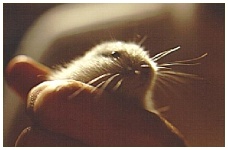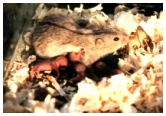
 The Furballs Are Coming! The lemming is the smallest mammal in the Arctic - but one of the most important. It is a main source of food for many predators, whose populations rise and fall according to the availability of these little critters. Lemming populations rise and fall dramatically, usually peaking about every 4 years and then dropping almost to extinction. With plentiful food supplies, predators flourish, overwhelming the lemmings whose population, with less breeding animals, starts to drop. Soon, the predators have insufficient food, and also start to drop in numbers. Fewer predators gives the lemmings a chance to increase again - until the hunters also start to gain in number. And so it goes...
Since the Middle Ages, people have had myths and legends about where all of the lemmings seemed to suddenly come from. Some believed the little furballs fell from the sky like rain, while others thought they were searching for their lost homes. Such events were even recorded by priests as an omen that war was coming!
|

|
DICTIONARY: Just "double-click" any unlinked word on this page for the definition from Merriam-Webster's Student Electronic Dictionary at Word Central. |

|
ARCTIC LIBRARY & GLOSSARY: Check this section for an index of the rest of the things you really need to know about the Arctic. |

|
ARCTIC MAPS & WEATHER REPORTS: Maps of the Northwest Passage, explorers' routes, iceberg sources, Nunavut, the Arctic by treeline, temperature... |

|
ARCTIC LINKS: Even more information! Links to sites related to the Arctic and "Iceberg: the Story of the Throps and the Squallhoots". |

|
GUIDE TO ARCTIC SUNRISE & SUNSET: How much sunlight or darkness is there in the Arctic on each day of the year? |
to is the property of their respective owners, and Athropolis is not responsible for their content.

